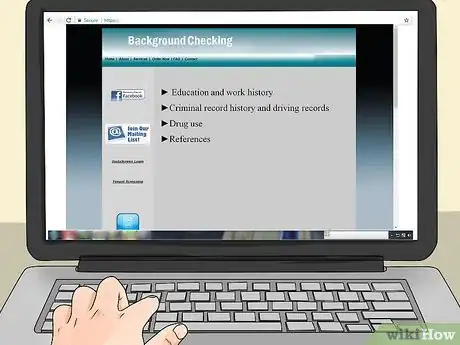This article was co-authored by Colleen Campbell, PhD, PCC. Dr. Colleen Campbell is the Founder and CEO of The Ignite Your Potential Centers, Career and Life Coaching based in the San Francisco Bay Area and Los Angeles. Colleen is an International Coach Federation accredited Professional Certified Coach (PCC). Colleen received her MA and PhD in Clinical Psychology from Sofia University and has been career coaching since 2008.
This article has been viewed 42,655 times.
Job shadowing is a great way to get an idea of what working your dream job is actually like! Whether you're a middle- or high-school student, a college senior about to graduate, or are looking for a career change, a job shadow can teach you about day-to-day rewards and challenges. Learning how to choose a job, ask for a shadowing opportunity, and behave like a professional will help you get the most out of your job shadow experience.
Steps
Choosing a Job to Shadow
-
1Determine what interests you. As you search for a potential career, the best place to start is with what interests you and what skills you have. Figure out what jobs involve a combination of the two and pursue the opportunity to participate in a job shadow.[1]
- You might be interested in art, science, law enforcement, factory work, finance, or culinary arts. Job shadowing is available in almost every industry, so think big!
- It's okay if you don't have all the skills required. Job shadowing can help you figure out if you want to pursue those extra credentials.
-
2Pick a specific job. Once you've thought about what kind of careers interest you, narrow it down to a specific job or position. It will be much easier to find a job shadow if you know what you are looking for.[2]
- For example, if you love the idea of working in finance, you could focus on shadowing a stockbroker, investment manager, or accountant.
- If you've always liked working with your hands, try shadowing a machinist, a mechanic, or a carpenter.
Advertisement -
3Pick three or four local workplaces. Make a list of local workplaces you're interested in. You may not be able to shadow at your first choice, so having a few backups is necessary.[3]
- You can find them by searching for your location and your dream job online, asking your school's job placement office, or even asking friends and family for recommendations.
- Be sure you have available transportation to all the companies on your list.
Finding a Job Shadow
-
1Ask your school for help arranging a job shadow. If you are still in school, talk to them about arranging a job shadow on your behalf. Many schools already have established programs or relationships with local workplaces. Ask your teacher, guidance counselor, or career services office for recommendations and contacts.[4]
- If you have already graduated, get in touch with your school's alumni office. They often have networking and job search resources.
-
2Check your personal network for potential connections. You may already know someone who can arrange a job shadow for you! Spend some time looking over your address book and social media lists for anyone who works at a place you'd like to shadow. Ask your friends and family if they know anyone who can put you in touch with a potential shadowing opportunity.[5]
-
3Look up the company's human resources division. If you aren't able to find a contact, go to the company or office website and look up their human resources or public relations division. Many workplaces, especially government offices and major corporations, have established job shadowing programs and will be able to help you.[6]
-
4Write a formal email request to your contact. Once you know who to get in touch with for a job shadow, write them a formal email asking for the opportunity to job shadow. The letter doesn't have to be long, but it should be polite, clear, and written in formal style.[7]
- You could try writing something like “Dear Sgt. Smith: I am a student at Springfield High School and I am hoping to pursue a career as a police officer. I'm writing you to ask if the Springfield Police Department has any opportunities for a job shadow in the near future. I am happy to submit to a background check. Thank you for your time, and I hope to hear from you soon. Sincerely, Kelly Jones.”
-
5Take a background check if necessary. Some job shadows require a background check. If you're asked to take one, be sure to send them all the information they need as soon as possible.
-
6Try an online job shadow. If you aren't able to find a job shadow in your area, search online for opportunities to online job shadow. These websites provide video tours, interviews with real employees, and opportunities to ask employees questions directly.[8]
Acting Professionally
-
1Research the job before you show up. A job shadow is designed to show you what day-to-day work is like, so you should already know a little about the field before you arrive. Ask your school or any contacts you have in the industry for information about the job. You can also search online for background information about your field.[9]
-
2Arrive on time and dressed professionally. Be sure to show up on time, or even a little bit early! Showing up late is unprofessional and can be a big inconvenience to the staff. Make sure you're wearing work-appropriate clothes, which can vary from industry to industry. It's okay to ask what to wear![10]
- For example, law and finance tend to be very formal, so you'd want to wear a suit in a conservative color. Other offices wear business casual, which usually means a dress shirt or blouse with a pair of slacks or a knee-length skirt.
- If you are shadowing a job that is outdoors, active, or involves machine or lab work, ask what to wear beforehand. Active workplaces often have strict rules about clothes for safety reasons, so things like open-toed shoes, jewelry, heels, dresses, or jackets might be a bad idea.
-
3Greet everyone politely. Make sure you say hello and introduce yourself to everyone you meet while job shadowing. You don't have to hold conversations with everyone, but they should know who you are and why you're there.[11]
- Try “Hi, I'm Kelly! I'm shadowing Officer Torres today.”
-
4Let the employees take the lead. When you're shadowing, don't try to dictate the workday or schedule visits yourself. You're supposed to be following an employee throughout their day to get an idea of what the actual work is like. Let the employee decide what tasks you'll be doing and what areas you'll be visiting.[12]
- If you would also like a tour of the facilities, be sure to ask in advance. They may not be able to accommodate you last-minute.
-
5Respect the workplace rules. A job shadow may not be able to show you everything you want to know about the job. Certain areas, files, and departments may be employees-only. If you are told not to do something, don't do it![13]
-
6Ask if you can help. If there's something you can do to help the person you're shadowing, ask them if you can do it. Some areas and industries have strict labor laws, so don't insist if they tell you no. Instead, offer to get them some water or a snack during your break.
-
7Ask questions. You're there to learn about the job, so take advantage of the opportunity by asking lots of questions. Questions like “What do you dislike about this job?”, “What is your biggest challenge here?”, and “How did you get into this field?” are good ways to learn about your chosen career.[14]
-
8Take detailed notes. Bring a notepad and a few pens and take detailed notes. Write down answers to your questions, things you like, and things you dislike about the job.[15]
- It might be tempting to take notes on your phone, but don't do it. It can look like you are playing with your phone instead of paying attention.
- Don't record or take pictures of anything unless they tell you in advance that it's okay.
-
9Send a thank-you note. When the job shadow is over, send a polite thank-you note. You should send one to the person you shadowed, and another to your original contact at the workplace. You can send it over email or regular mail.[16]
- Good thank-you notes are short and specific. Try “Dear Officer Torres: Thank you for having me as a job shadow yesterday. I learned a lot about police work and I'm excited to pursue a career in law enforcement. Sincerely, Kelly.”
Expert Q&A
-
QuestionWhat is the goal of job shadowing?
 Colleen Campbell, PhD, PCCDr. Colleen Campbell is the Founder and CEO of The Ignite Your Potential Centers, Career and Life Coaching based in the San Francisco Bay Area and Los Angeles. Colleen is an International Coach Federation accredited Professional Certified Coach (PCC). Colleen received her MA and PhD in Clinical Psychology from Sofia University and has been career coaching since 2008.
Colleen Campbell, PhD, PCCDr. Colleen Campbell is the Founder and CEO of The Ignite Your Potential Centers, Career and Life Coaching based in the San Francisco Bay Area and Los Angeles. Colleen is an International Coach Federation accredited Professional Certified Coach (PCC). Colleen received her MA and PhD in Clinical Psychology from Sofia University and has been career coaching since 2008.
Career & Life Coach Job shadowing can help you figure out if a particular career is right for you. Job shadowing should just be one part of your exploring process. Think about your personality, strengths, and values when you're evaluating whether you'd be a good fit for a position.
Job shadowing can help you figure out if a particular career is right for you. Job shadowing should just be one part of your exploring process. Think about your personality, strengths, and values when you're evaluating whether you'd be a good fit for a position.
References
- ↑ https://www.livecareer.com/quintessential/job-shadowing
- ↑ https://www.monster.com/career-advice/article/the-job-shadow-knows-try-on-a-career-before-you-commit-hot-jobs
- ↑ https://www.livecareer.com/quintessential/job-shadowing
- ↑ https://www.livecareer.com/quintessential/job-shadowing
- ↑ https://www.livecareer.com/quintessential/job-shadowing
- ↑ https://www.monster.com/career-advice/article/the-job-shadow-knows-try-on-a-career-before-you-commit-hot-jobs
- ↑ https://www.livecareer.com/quintessential/job-shadowing
- ↑ http://www.jobshadow.com/what-youll-learn-here/
- ↑ https://www.livecareer.com/quintessential/job-shadowing
- ↑ https://www.monster.com/career-advice/article/the-job-shadow-knows-try-on-a-career-before-you-commit-hot-jobs
- ↑ https://www.monster.com/career-advice/article/the-job-shadow-knows-try-on-a-career-before-you-commit-hot-jobs
- ↑ https://www.monster.com/career-advice/article/the-job-shadow-knows-try-on-a-career-before-you-commit-hot-jobs
- ↑ https://www.monster.com/career-advice/article/the-job-shadow-knows-try-on-a-career-before-you-commit-hot-jobs
- ↑ http://www.jobshadow.com/what-youll-learn-here/
- ↑ https://www.monster.com/career-advice/article/the-job-shadow-knows-try-on-a-career-before-you-commit-hot-jobs
- ↑ https://www.monster.com/career-advice/article/the-job-shadow-knows-try-on-a-career-before-you-commit-hot-jobs













































































